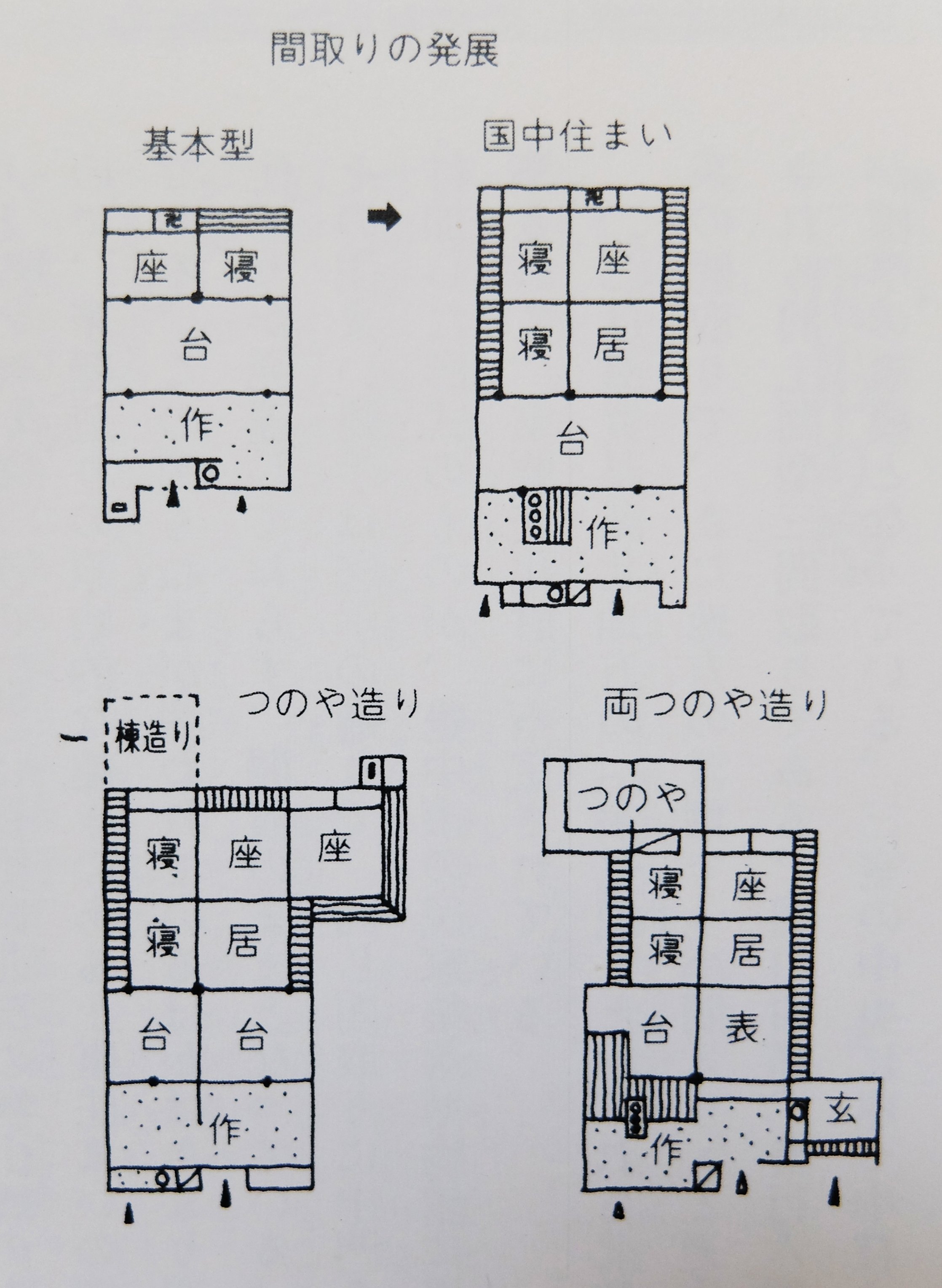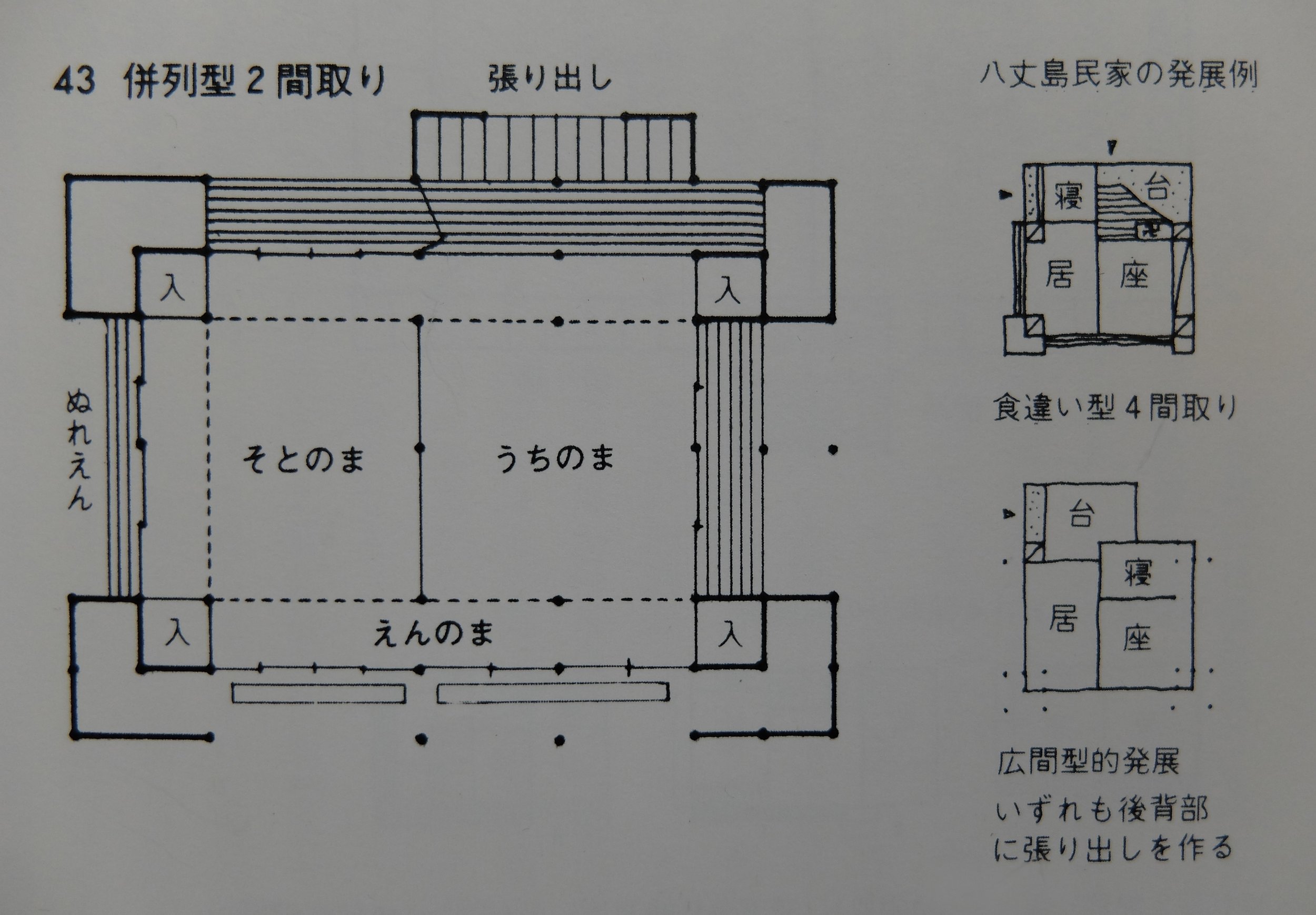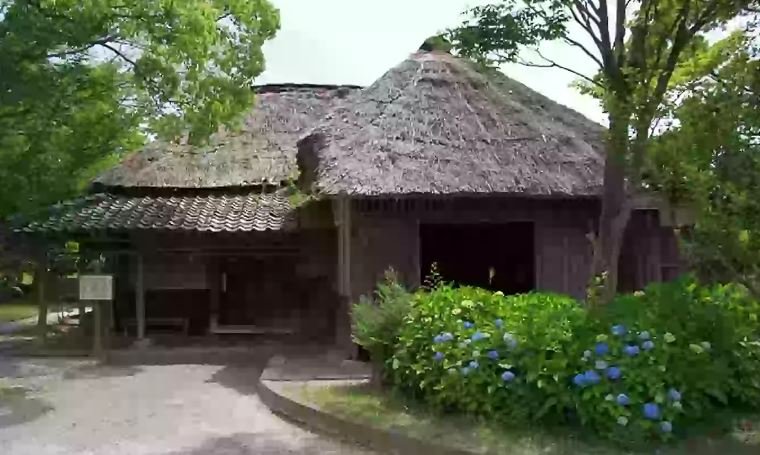Last week’s post discussed the front-zashiki three-room layouts of the Kinki region. There is another three-room precursor to the regular four-room layout (seikei yon-madori 整形四間取り), also found in Kinki: the ‘staggered type three-room layout’ (kui-chigai kata san-madori 食違い型三間取り). This layout type is distributed from the areas straddling the Kinokawa (紀の川) River in Wakayama and О̄saka Prefectures down to the lower reaches of the Yoshino River 吉野川 (which is what the Kinokawa River is called in Nara Prefecture). The plan below, of the Ueno house (Ueno-ke 上野家) in Sennan County (Sen-nan-gun 泉南郡), О̄saka Prefecture, is a representative example. The type is a variety of front-zashiki layout, but with a ‘living-dining room’ (daidoko だいどこ), for dining and ‘family gathering’ (danran 団らん), that is fully open to, and projects out into, the doma (here called the niwa). From this feature, the layout is also described as henkei (変形), which can variously mean ‘deformed’, ‘transformed’, or ‘modified’; it could be argued that this is a more accurate description than ‘staggered’ (kui-chigai 食違い), or even that the layout is not truly staggered at all, since there is no ‘cross’ (jūji 十字) of partition lines to be staggered in a three-room layout.
A very similar two-room form can be found in Taki County (Taki-gun 多気郡) in Mie Prefecture, as covered in the previous series of posts on two-room layouts. Interestingly, these minka types are distributed in a pattern that exactly traverses the root of the Kii Peninsula (Kii Hantо̄ 紀伊半島).
A front-zashiki type layout, but the rear daidoko is large and offset from the zashiki, extending out into the doma to form a staggered three room layout. Labelled are: the earth-floored utility area (niwa にわ) for food storage (shokuryо̄ chozо̄ 食糧貯蔵), food preparation (tabemono chо̄sei 食物調整), feed preparation (shiryо̄ chо̄sei 飼料調整), agricultural work (nо̄-sagyо̄ 濃作業), and handwork (te-shigoto 手仕事), with stable (maya まや) for raising livestock (kachiku shi-iku 家畜飼育) and entry doma (iriguchi doma 入口土間); the ‘living-dining’ room (daidoko だいどこ), open (kaihо̄ 開放) to the niwa, for dining (shokuji 食事), family time (danran 団らん), entertaining (о̄tai 応対), and handwork (te-shigoto 手仕事); the bedroom (nando なんど) for sleeping (shūshin 就寝) and family possessions (kazai 家財); and the formal room (zashiki ざしき), for ceremonies (gyо̄ji 行事), sleeping (shūshin 就寝), and receiving guests (sekkyaku 接客), with alcove (butsuma 仏間) for Buddhist altar (marked manji 卍), decorative alcove (toko とこ), and shelves (tana たな). Sennan County, О̄saka Prefecture.
Two paths of development of this layout are shown in the plans below. The upper three plans show the path of development of minka, such as the Ueno house, in Sennan County: the partition at the boundary between daidoko and nando is extended forward and the plan becomes a ‘modified’ (henkei 変形) four-room layout (yon-madori 四間取り). At this point the plan is no longer staggered but ‘regular’ (seikei 整形), as the two perpendicular partition lines intersect at a single point, in a cruciform configuration (jūji-gata 十字型). The plan then develops into a regular four-room layout (seikei yon-madori 整形四間取り) as the niwa boundaries of the daidoko and ima are aligned, though the projection of the daidoko lives on as a boarded ‘deck’ extending out into the niwa.
The lower three plans are of a minka in Naka County (Naka-gun 那賀群) in Wakayama Prefecture: again, the partition at the boundary between daidoko and nando is extended forward and the plan becomes a regular but ‘modified’ four-room layout. With the addition of a fifth room, however, the plan reverts to a staggered layout: on the Wakayama Prefecture side of the distribution, in Naka County (Naka-gun 那賀群) and Ito County (Ito-gun 伊都郡), there is a tendency to return to or retain the staggered configuration as the number of partitions and rooms increase.
Two paths of development of the ‘deformed’ (henkei 変形) front-zashiki three-room layout. The top row illustrates the development of the Sennan County, О̄saka Prefecture minka shown in the large plan above. The bottom row shows the path of development of a minka in Naka County, Wakayama Prefecture. Labelled are the stable (maya, here marked ushi 牛, lit. ‘cow’), the ‘living-dining’ room (daidoko, marked dai 台), bedroom (nando, marked ne 寝), ‘formal room’ (zashiki, marked za 座), and ‘living room’ (ima, marked i 居).
















































































